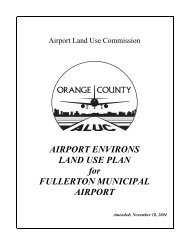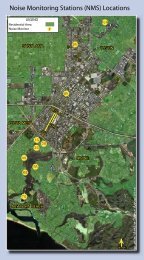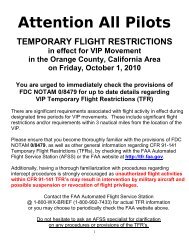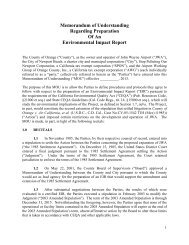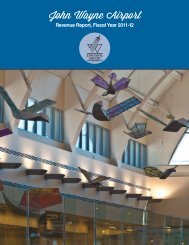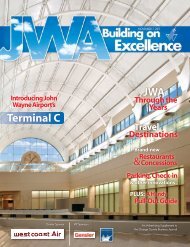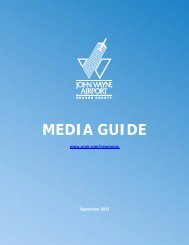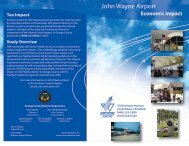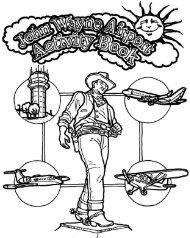PDF - John Wayne Airport
PDF - John Wayne Airport
PDF - John Wayne Airport
Create successful ePaper yourself
Turn your PDF publications into a flip-book with our unique Google optimized e-Paper software.
JOHN WAYNE AIRPORT<br />
Notes to Financial Statements (Continued)<br />
For the Years Ended June 30, 2011 and 2010 (to the nearest thousand)<br />
JOHN WAYNE AIRPORT<br />
Notes to Financial Statements (Continued)<br />
For the Years Ended June 30, 2011 and 2010 (to the nearest thousand)<br />
Note 1 – Reporting Entity and Summary of Significant Accounting Policies (continued)<br />
Passenger Facility Charges (continued)<br />
The FAA approved the <strong>Airport</strong>’s PFC application to collect $4.50 per enplaned passenger effective July<br />
1, 2006. The total approved PFC revenue to be collected is $321,351 through December 31, 2021.<br />
All PFCs collected are restricted and are categorized as nonoperating revenues. PFCs collected are<br />
maintained in an interest-bearing account administered by the Orange County Treasurer. Collected but<br />
unexpended PFC revenues are reported on the <strong>Airport</strong>’s Statement of Net Assets as current restricted<br />
assets, pooled cash and investments held with the Treasurer and cash and investments with trustee.<br />
Related PFC receivables are also reported as current restricted assets.<br />
During the fiscal years ended June 30, 2011 and 2010, $18,031 and $18,053 in PFC revenue was<br />
collected and $11,148 and $3,370 was expended on FAA approved projects, respectively.<br />
Basis of Presentation - Fund Accounting<br />
The operations of the <strong>Airport</strong> are accounted for as an enterprise fund. Enterprise funds are used to<br />
account for activities that are financed and operated in a manner similar to private business enterprises<br />
where the intent of the governing body is that costs of providing services to the general public on a<br />
continuing basis be financed or recovered primarily through user charges.<br />
Under Governmental Accounting Standards Board (GASB) Statement No. 20, Accounting and<br />
Financial Reporting for Proprietary Funds and Other Governmental Entities that Use Proprietary Fund<br />
Accounting, the <strong>Airport</strong> has elected to apply all applicable Financial Accounting Standards Board<br />
(FASB) Statements and Interpretations, Accounting Principles Board Opinions and Accounting<br />
Research Bulletins issued on or before November 30, 1989, unless those pronouncements conflict with<br />
or contradict GASB pronouncements. The <strong>Airport</strong> has elected not to apply FASB pronouncements<br />
issued after November 30, 1989 when preparing the fund financial statements.<br />
Basis of Accounting and Estimates<br />
The <strong>Airport</strong> prepares its financial statements on the accrual basis of accounting in conformity with<br />
generally accepted accounting principles (GAAP), which provides that revenues are recorded when<br />
earned and expenses are recorded when incurred. The preparation of financial statements in conformity<br />
with GAAP requires management to make estimates and assumptions that affect the amounts reported in<br />
the financial statements and accompanying notes. Actual results could differ from those estimates.<br />
Note 1 – Reporting Entity and Summary of Significant Accounting Policies (continued)<br />
Basis of Accounting and Estimates (continued)<br />
The principal operating revenues of the <strong>Airport</strong>’s enterprise fund are charges to customers for use of<br />
property and for services provided. Operating expenses include the cost of services, administrative<br />
expenses, and depreciation on capital assets. All revenues and expenses not meeting this definition are<br />
reported as nonoperating revenues and expenses.<br />
Capital Assets<br />
Capital assets including infrastructure assets, purchased or constructed by the <strong>Airport</strong> are capitalized at<br />
cost, while contributed properties are recorded at fair market value when received. Assets are<br />
capitalized when the original unit cost is equal to or greater than the County’s capitalization threshold of<br />
$5 for equipment, $150 for structures and improvements, $0 for infrastructure and $0 for land.<br />
Depreciation is provided on a straight-line basis over the estimated useful lives of the related assets,<br />
which range from 3 to 20 years for equipment and 15 to 45 years for infrastructure and structures. No<br />
depreciation is provided on construction in progress until construction is completed and the asset is<br />
placed in service.<br />
Capitalization of Interest<br />
Interest incurred during the construction phase is included as part of the capitalized value of the capital<br />
assets constructed. In the case of capital acquisitions financed by externally restricted tax-exempt debt,<br />
the amount of interest capitalized is calculated by netting interest expense on a borrowing against related<br />
interest earnings on the reinvested unexpended debt proceeds. During the fiscal year ended June 30,<br />
2011, the total interest expense and interest revenue were $11,273 and $618, respectively, and the net<br />
amount of $10,655 was included as part of the cost of capital assets under construction financed by<br />
externally restricted tax-exempt debt. For fiscal year ended June 30, 2010, the total interest expense and<br />
interest revenue were $11,153 and $2,329, respectively, and the net amount of $8,824 was included as<br />
part of the cost of capital assets. For capital acquisitions financed by existing resources, the total interest<br />
expense incurred and the amount included as part of the cost of capital assets under construction for the<br />
fiscal years ended June 30, 2011 and 2010 were $1,490 and $1,641, respectively.<br />
Premiums/Discounts, Deferred Refunding Amounts and Issuance Costs<br />
Bond premiums and discounts as well as issuance costs and deferred amounts on refundings, are<br />
deferred and amortized over the term of the bond using the effective interest rate method.<br />
Enterprise funds distinguish operating revenues and expenses from nonoperating items. Operating<br />
revenues and expenses generally result from providing services and producing and delivering goods in<br />
connection with an enterprise fund’s principal ongoing operations.<br />
2011 ANNUAL REPORT > 12 2011 ANNUAL REPORT > 13



